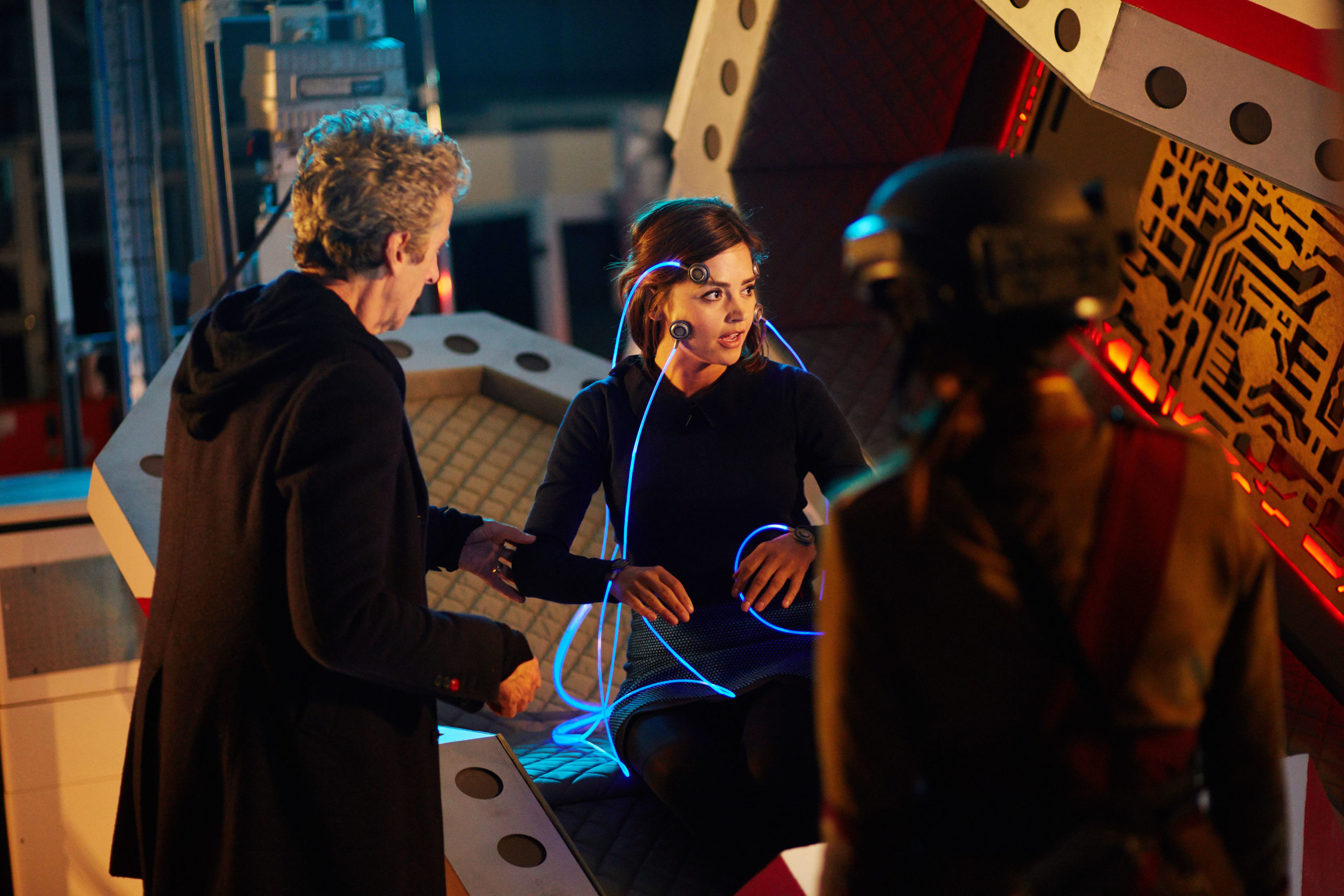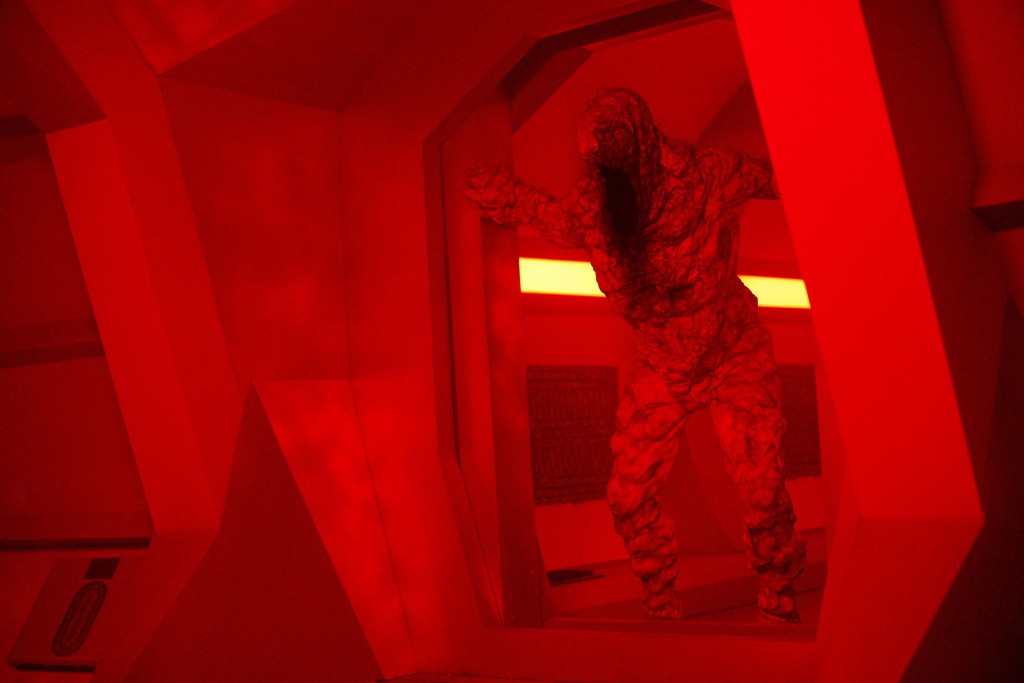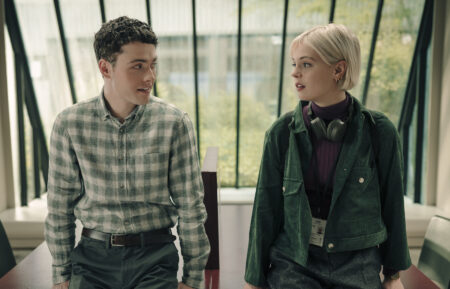‘Doctor Who’s “Sleep No More”: 8 Revelations About That Scary Episode

Spoiler alert! Don’t read on if you haven’t watched the most recent episode of Doctor Who.
Whovians who watched “Sleep No More,” the latest episode written by Mark Gatiss, were treated to an unsettling story about a future where sleep has almost been eradicated to increase efficiency and expediency. Of course, this unnatural trend causes something bad to happen—in this case, the rise of a terrifying new, ever-evolving humanoid creature, called the Sandmen, which the Doctor calls “an abomination.”
After writing many episodes set in the past, Gatiss wrote his first script set in the (very) far future—the 38th Century—when Indo-Japanese culture is predominant on Earth, and Neptune’s moon, Triton, has been colonized. The episode starts with a rescue crew docking at Le Verrier Space Station, only to discover the Doctor and Clara roaming the halls. The station is silent and empty, but everyone has the strange sense of being watched at all times. Eventually, they discover a room full of Morpheus sleeping pods (named after the Greek god of dreams, not the Matrix mentor) that allow people to get a month’s worth of sleep in a very short amount of time. They discover Rasmussen (Reece Shearsmith), who claims to be the only crew left, hiding in a pod. But upon trying to leave the station, they all encounter faceless, lumpy and carnivorous creatures that can “disperse” at will.
And since this particular episode is the first to use found footage as a storytelling device, all the Doctor-Clara action scenes are spliced with found footage narration by Rasmussen, who tells the unfolding story and warns viewers to stop watching, or else they become immobilized by fear.
We spoke to Gatiss to learn more about where the idea for this episode came from, and what inspired him to create the Sandmen. Here is what we learned.
Insomnia inspired the idea for “Sleep No More.” An insomniac, Gatiss is “very interested in the mechanics of sleep” and one particular night, he began thinking about the modern world’s inability to disconnect. “I was just lying awake staring at the ceiling. I thought a lot about how we are so driven. You can’t miss a phone call anymore. Nobody’s ever off. We’re basically always on the whole time,” he recalls. “So I had this idea, in the distant future, a process will be invented called the Morpheus process, which reduces the need to sleep to five minute bursts. You can work for a week without stopping.”
The title is definitely a nod to Macbeth. The phrase “sleep no more” is from the play. Gatiss said, “The Doctor quotes it. It actually came out of a conversation that I had with Steven [Moffat] and Brian [Minchin], and it was actually their only note, ‘We need to kind of give it a mythic dimension.’ And there’s this beautiful section from Macbeth, which says it all.” And during the meat locker scene, “The Doctor has this indignant speech about the fact that sleep is essential to every sentient being in the universe but for the humans, ‘greedy, filthy, stupid’ humans, it’s a commodity to be bartered away.'” But by the end of the episode, everyone learns sleep shouldn’t be meddled with. As the Doctor says, “Sleep is wonderful. Sleep is vital. Even I sleep.”
Yes, something gross really led to the creation of the Sandmen. “Eye crust is not benign. It’s literally the Sandmen,” Gatiss explained, about taking the build-up of mucus and cells in eye corners (as the Doctor explains) to compose the new Whoverse creature. And choosing the 1954 song, “Mr. Sandman,” by The Chordettes as the theme song for the Morpheus program was a no-brainer. According to Gatiss, adding the cheerful song to the dark episode made it even more creepy. “‘Mr. Sandman’ is very spooky and strange. It’s so relentlessly upbeat,” he mused.
Gatiss definitely set out to scare viewers (within reason). Even though Who has become known as a family show, there’s always been a scary undercurrent to it. “It’s hugely about humor, it’s hugely about the emotion, but fundamentally it’s a scary program. It’s a safe scare for children and families,” Gatiss explained. “To use the German term, unheimlich, there’s something uncanny about automatons, the Cybermen, the Daleks, the terrifying Weeping Angels. The most successful modern monster is…just a scary idea. Scary image but also scary idea. Rarely is it visceral, rarely is it gore. It’s much creepier to imply things.” And seeing how the episode ends with Rasmussen “dusty” self, Gatiss certainly succeeded.
RELATED: 8 Scary Doctor Who Episodes That Will Make You Sleep No More
The episode was almost a two-parter. In fact, Gatiss had a lot of things worked out about the whole society around Neptune and its main moon, Triton. Originally, he wrote more about the two factions, called the “Wide Awakes” and the “Rip Van Winkles” (who actually sleep), that’s briefly mentioned by the Morpheus hologram. Gatiss had planned a satire on capitalization, but then he became interested in using the found footage genre for a stand-alone episode.
Rasmussen created his film before and after the Doctor and Clara arrive at Le Verrier. Gatiss admits some viewers might be left with the “mental problem” of when Rasmussen created his found footage. Turns out, the devious man prepped his “alibi” in advance to preempt any questions about Le Verrier’s crew disappearing. Then, he waited for the right time to add his perceived ending (essentially, everyone dying except him and the Sandmen) later on, after everyone was on board. Ironically, in crafting his alibi, he “essentially made a horror film,” Gatiss pointed out.
A few Easter eggs were hidden in the episode. The name Le Verrier is a nod to the celestial mathematician Urbain Le Verrier, who used math to calculate the existence of Neptune before it was discovered. As for the name Rasmussen, it’s not connected to the Star Trek: The Next Generation character. Gatiss simply chose it because he loves the Scandanavian name. Also, though he didn’t go into detail, he did share that “there are a couple of references to old stories,” including the connection to the 1984 Doctor Who novel, Frontios.
There might be a sequel—who knows?! Viewers were probably surprised by the episode’s abrupt ending, which saw the Doctor, Clara and Nagata (Elaine Tan) escape Le Verrier in the TARDIS without finding out what the Sandmen are or how they really came into existence via the Morpheus program. Gatiss revealed, “The Doctor doesn’t have to win. He knows something is up but it’s left ambiguous. So potential sequel?” And after watching this skin-crawling episode, we can only hope.
Doctor Who, Saturdays, 9/8c, BBC America










